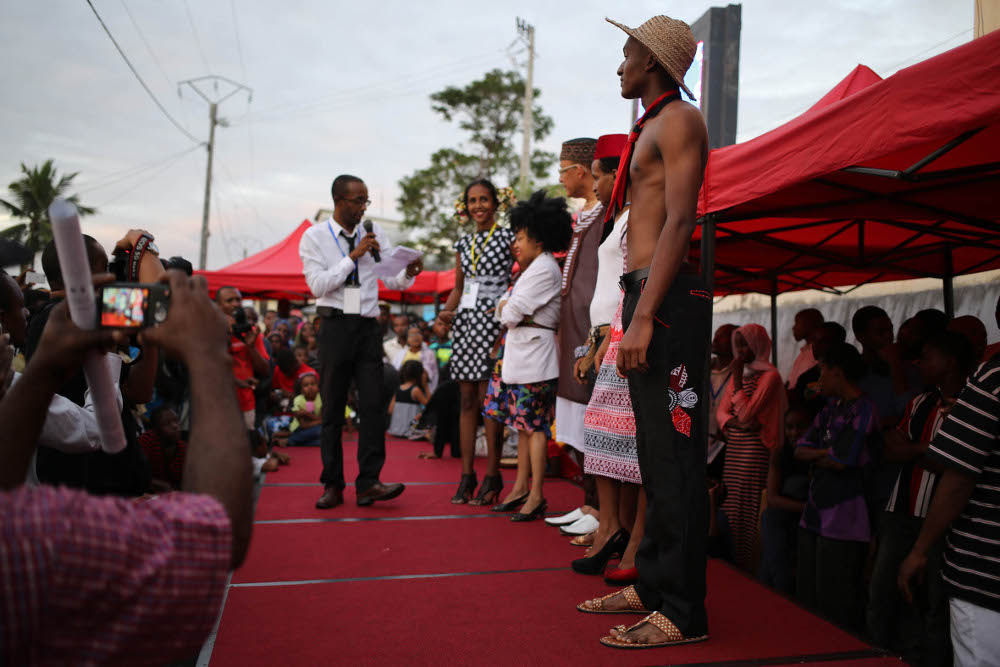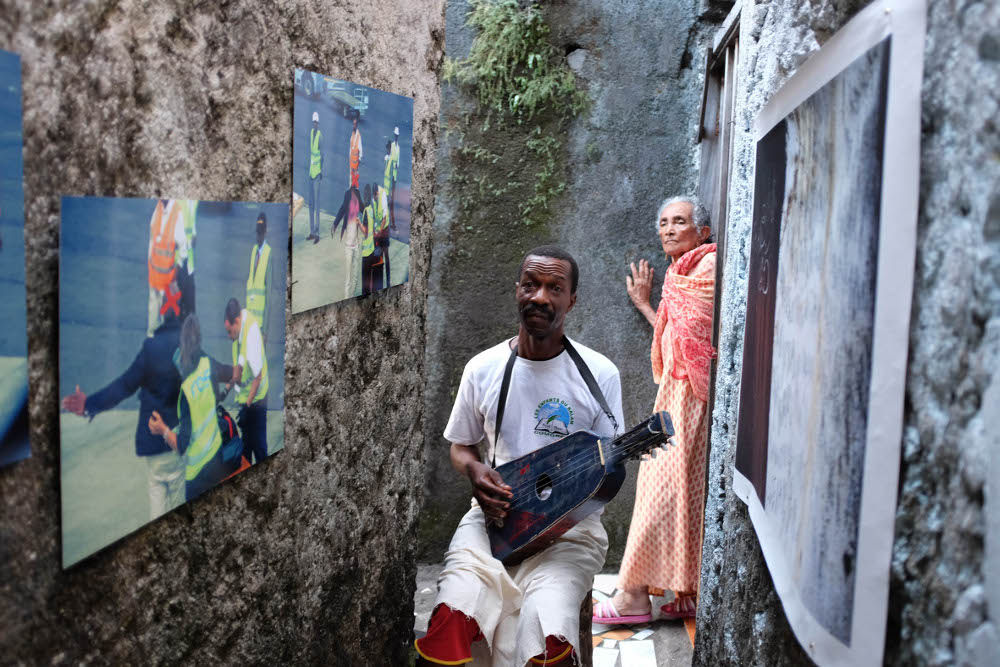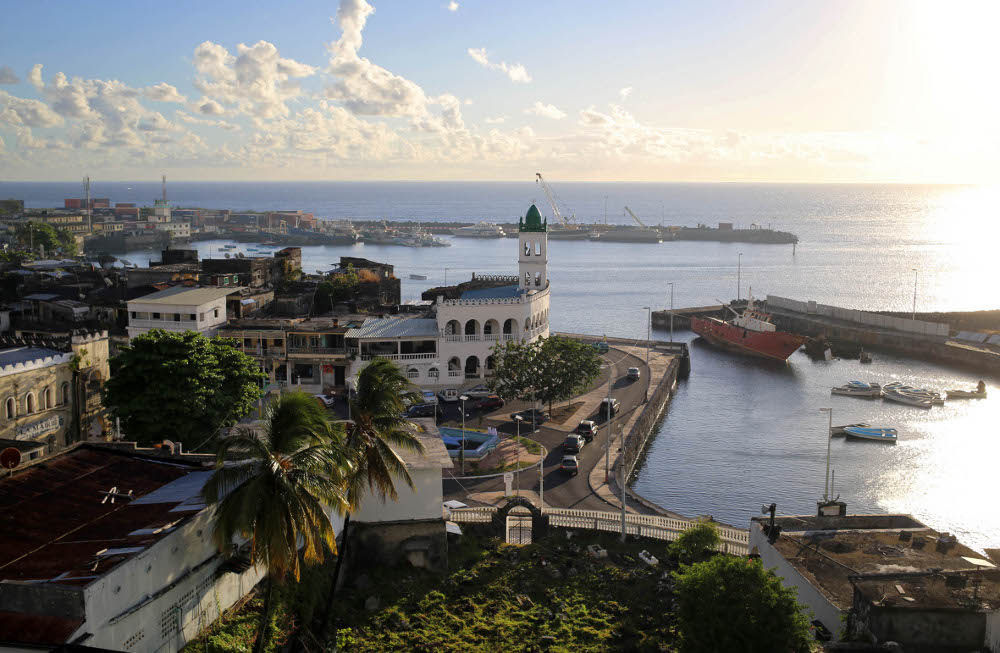Islam shuns depiction of the human figure but Comorians had no problem with these photos on a wall facing the historic Badjanani mosque in Moroni.
Moroni, capital of the Comoros islands, must be the only city in Africa where hairdressers piously advertise their trade with paintings of combs and scissors, instead of faces and hairstyles.
Nonetheless, one day in early June, a Congolese artist wearing long dreadlocks and shorts is painting a semi-naked woman on a wall of the medina, the old Arab quarter. A giant photograph of a ballet dancer’s legs en pointe faces the grand Badjanani mosque, dating from the 15th century. Yet locals react with curiosity, not hostility.
Welcome to Africa’s newest and least known art biennale: the festival of contemporary arts in the Comoros. Now in its second edition (the first was in 2012), its charm lies in its spontaneity and the way it confronts the city and its residents with modern art.
The Comoros being one of Africa’s poorest countries, organising the festival requires huge fundraising and logistical efforts, driven by the passion of its directors, Denis Balthazar, an artist from Guyana, and Fatima Ousseni, a Comorian lawyer. They are married, live in Mayotte and four years ago had this mad idea of an art fest in Moroni.
And what a fiesta it is. A catwalk for a fashion show in the middle of the busy Volo-Volo market. Nearby, a show of martial arts infused with African flavour, from Senegalese boxing to tae kwon do. The Parliament building and the Women’s Hall taken over by film screenings, traditional song and dance, paintings, sculptures, installations and photos by a Haitian collective.
Cultural identity
Ousseni says that “art can help us restructure our cultural identity as deconstructed people”. Hence the festival includes a science arm, with visiting academics like Guinean historian Djibril Tamsir Niane lecturing at the university and an outreach arm for high school students.
Radiating bonhomie throughout are the godparents of the festival: Paris-based Comorian designer Sakina M’sa, who does geometric dresses combining blocks of strong colours, and Alphadi (real name Sidahmed Seidnaly), an iconic designer from Niger and the engine behind the marvellous biannual African fashion festival in the Ténére desert region.

Paris-based Comorian designer Sakina M’sa (in white jacket) sponsored a fashion show by local stylists in the Volo-Volo market. (Photos: Daniel Brown)
Alphadi is having a ball in the Comoros. “I enjoy visiting a tolerant Muslim country where races and cultures mingle. This is a festival of métissage (fusion), just like my fashion style is fusion; both blacks and whites can use my clothes. The future of the world is métissage!” he enthuses.
“The festival allows us to open up to the world and the world to come to us,” says Seda, a Comorian artist, interior decorator and crafter of bags and jewellery using recycled paper and plastic.
A number of artists here have come from Réunion, Seychelles, Madagascar, Haiti, Guyana and Congo – the periphery of Francophonie (France’s sphere of post-colonial influence) – and have deconstructed old and new colonialism in their work.
Compelling art
For me, the most compelling art work is the four-part performance by Soeuf Elbadawi, a Comorian artist. Short, stocky, dreadlocked and intense, he is gruff in demeanour and diamond-sharp in his work.
Titled Moon Country: A Broken Dream (Comoros means moon – qamar – in Arabic), the performance takes groups of 10 people on a physical, intellectual and aesthetic trip into the medina. Along alleys, up stairs, into courtyards and nooks made of coral stone, to three spots featuring storytelling: someone prays, sings, reads poems and tells stories about the Comorian dhows, now gone (the last dhow went to a Venice biennale and ended up staying there).
Musician Mwinyi Mmadi plays a weird home-made guitar made with strings of fishing line and sporting an amazingly clear sound, melancholic and plaintive, his voice rippling in guttural singing like the marabouts (holy men) do when possessed.

The plaintive sound of Mwinyi Mmadi’s homemade traditional guitar soars through the old Arab quarter of Moroni during the festival of contemporary arts in the Comoros.
In a dark alcove, Elbadawi tells us his family‘s history of exploitation by the French and speaks of unfinished “mental decolonisation”. His piece is a political and poetic interrogation of 40 years of independence “of this deconstructed archipelago, whose people are but consumers waiting for the diaspora”.
The performance ends at night at the central Place de France, lined with French banks. Lit up by paraffin lamps and car headlights, girls and boys from a madrassa sing, young men in white djellabas (loose hooded cloaks) perform spirited Sufi dances. Elbadawi sets down the first stone of a monument to Comorians who drowned or were arrested and deported trying to reach the archipelago’s French-controlled Mayotte island, seeking work and healthcare. He turns his sorrow and rage into a haunting work of art.
Gaza flotilla
Israeli artist Maayan Amir puts a bunch of artists in a boat to re-enact the flotilla that tried to reach Gaza in May 2010, flying a Comorian flag. Five strong Comorian swimmers with snorkels play the Israeli police, and promptly stop the artists who jump into the blue water and swim ashore. In a role reversal, their action evokes French police stopping Comorians from reaching Mayotte.
Sure, there is a fair share of bad art, beginner’s art, delays, technical glitches, a mike annoyingly dead when Alphadi lectures on African textiles, and the frequent power shortages that Comoros suffers daily.
But the freshness of the festival, the goodwill of Comorians and the improbability of the crazy project on this remote island by far compensate for the hurdles. If showing the human figure constitutes a radical gesture, then a boring, naturalistic portrait oozes defiance.
The festival seeks to prove that art and fashion can bring jobs, publicity and tourism, and erode the image of Comoros as an unstable, coup-prone country. “Art is development; art creates employment,” Alphadi cheerfully tells every official he meets.
The Comoros at a glance
- The Union of the Comoros comprises three volcanic islands – Ngazidja, Ndzwani and Mwali. A fourth island, Mayotte, remained under French jurisdiction at independence in 1975 – a sore point with Comorians.
- Its people (population 800 000) combine Arab, African, Portuguese, Persian and South-East Asian origins, in a centuries-old process of biocultural admixture.
- The Comoros exports ylang-ylang, vanilla, cloves and its labour. Some 200 000 Comorians live abroad and their remittances power the economy and families. With 50 000 Comorians, Marseilles, in France, has the largest concentration of Comorians after Moroni, the island nation’s capital.
- The Comoros has been infamously unstable since independence, with 20 coups or attempted coups since 1975, several led by mercenary Bob Denard. When the island of Ndzwani (Anjouan) tried to secede in 2001, Thabo Mbeki and Nkosazana Dlamini-Zuma mediated a compromise.
- During the sanctions years of apartheid, the Comoros was one of the few places where South African planes could land and bring tourists to the Southern Sun hotel in the north of Ngazidja. The hotel closed a decade ago during a time of instability. Its 430 former workers are still prized for being well trained and are proud to point out that they worked at the Sun.
- The Comoros ranks 169th among 189 countries in the United Nations Development Index, and 32nd out of 52 countries in the Ibrahim Index of African Governance. It has high unemployment and little tourism, serves no alcohol and is remarkably crime free.
- Flights are via Nairobi or Antananarivo.

The harbour at Moroni, the capital of the Comoros islands.